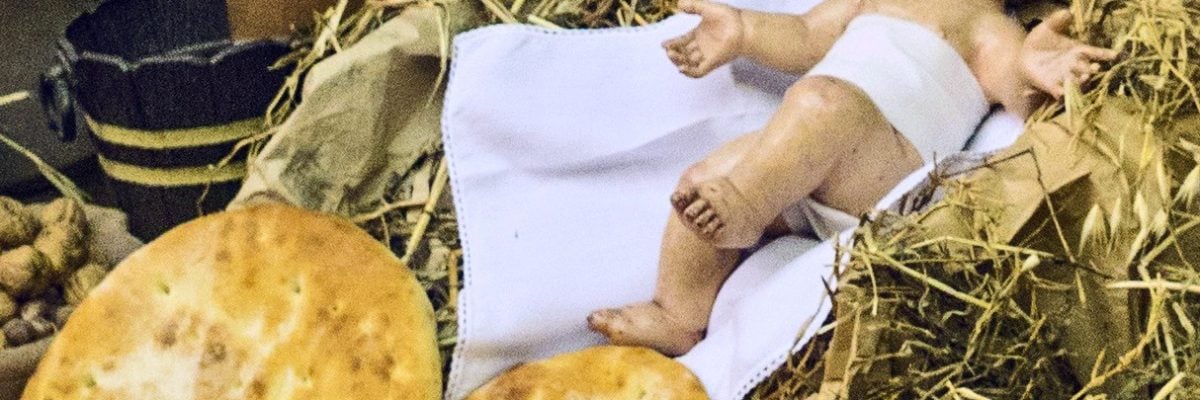
Knowing that his divine Son would become “the living bread which came down from heaven,” providing his Eucharistic “flesh” so that we could “live forever” (John 6:51), the Father aptly had Jesus born in the town of Bethlehem (“House of Bread”). This fulfilled Old Testament prophecy (see Matt. 2:5-6; Mic. 5:2-4); but more than that, his Blessed Mother “laid him in a manger” (Matt. 5:7), a further sign that Jesus would offer humanity heavenly food.
Some Christians disagree, arguing that the Catholic Church is wrong historically on the Eucharist. They say that the Early Church Fathers—and the New Testament that they explicate—teach that the Eucharist is purely a symbolic recollection of Christ’s sacrifice at Calvary. Thus, they maintain, in the famous Bread of Life Discourse of John 6, Jesus speaks in a merely figurative manner regarding eating his body and drinking his blood, which metaphorically refer to the “consumption” of his teaching and thus doing the will of his heavenly Father.
One such Christian is Protestant apologist Brian Culliton, who countered that my response to his essay earlier this year was unpersuasive:
The primary thing Tom Nash did not do in his response to my article, was to explain anything. He completely relied on the mindset of Catholics to interpret excerpts from Irenaeus as they have been conditioned to do. In contrast I have provided context and explanations which I think are preferred by reasonable people.
The Catholic Church agrees with Culliton that Jesus’ words in John 6—and the synoptic Gospel accounts of the Last Supper—have a symbolic meaning, but says further that Jesus also meant his words literally. In other words, it’s a both/and, not an either/or.
Catholic teaching holds up better to exegetical and other historical analysis than Culliton’s reasoning. In John 6, Jesus tells his Jewish followers that “he who eats my flesh and drinks my blood has eternal life, and I will raise him up at the last day. For my flesh is food indeed, and my blood is drink indeed” (John 6:54-55). Many of his disciples then respond, “This is a hard saying; who can listen to it?” (John 6:60), which makes no sense unless they understood Jesus literally.
Our Lord’s subsequent words do not assuage their doubts, because “after this many of his disciples drew back and no longer went about with him” (John 6:66). And Jesus does nothing to correct their alleged misunderstanding; whereas he does when his disciples make an erroneous literal inference about “the leaven of the Pharisees and Sadducees” (Matt. 16:6; see 16:5-12).
In addition, a figurative reading simply won’t work, because an ancient Hebrew idiom already assigned a figurative meaning to eating someone’s flesh: it meant to slander someone or even desire his death. For his hearers, in the figurative sense Jesus would’ve been promising heaven to those who maligned him; an absurdity that would’ve made Christ’s words laughable, not “a hard saying” (see Psalms 27:2). Instead, many Jews sought to kill Jesus (John 7:1) because they inferred he was indeed commanding them to actually drink his blood, which, in their minds, was an apparent and grave violation of Old Covenant law (Lev. 17:10-14; Deut. 13:1-5; see Gen. 9:4).
St. Paul’s teaching on the Eucharist also affirms the Real Presence of Christ in the Eucharist, for how could Jesus’ disciples “be guilty of profaning the body and blood of the Lord” and get sick—and even die—if they were consuming mere bread and wine? (1 Cor. 11:27-30).
In his book Hostile Witnesses, Gary Michuta notes that early pagan writers ironically affirm the Church’s teaching. For example, in The Annals (A.D. 109), Roman historian Tacitus speaks of Christians who were “hated for their abominations”:
One candidate is the celebration of the Eucharist, in which Christians believed they were consuming Christ’s actual body and blood (under the appearances of bread and wine). As we have seen earlier [John 6], the hostile witnesses of Jesus’ day, including some of his disciples, recoiled at this same teaching.
Given the persecutions Christians faced in the early Church, one would expect Church leaders to correct any pagan misunderstandings to preempt needless suffering. Instead, we see St. Ignatius of Antioch—a contemporary of Tacitus—rebuking misguided Christians who denied the Real Presence:
They [the Docetists, early Christological heretics] abstain from the Eucharist and from prayer because they do not confess that the Eucharist is the flesh of our Savior Jesus Christ, flesh which suffered for our sins and which that Father, in his goodness, raised up again. They who deny the gift of God are perishing in their disputes (Letter to the Smyrnaeans 6:2–7:1 [A.D. 110]).
A couple of years later, Pliny the Younger (circa A.D. 112), the governor of Bithynia in Asia Minor (modern-day Turkey), indicates that he sought out the Eucharistic celebration—which the early Church details in chapters 9 and 10 of the Didache (circa A.D. 100)— as the source of these Christian “abominations.” In a letter to the Roman emperor Trajan, Pliny writes of the Christians’ “meeting together for the purpose of taking food—food, that is, of an ordinary and innocent kind. . . . I could discover nothing else than a vicious and extravagant superstition.” Given Roman concern about Christian “abominations,” Pliny expresses relief that the food is apparently “ordinary and innocent,” yet still based on “a vicious and extravagant superstition,” which all stems from his own cannibalistic misunderstanding of the Eucharist.
Further, as Michuta notes, the Roman pagan writer Caecilius records that Marcus Cornelius Fronto—a Roman counsel and rhetorician (A.D. 100-166)—“identified Christian worship as involving ritual murder and cannibalism,” and that in Octavius 31, the Christian writer Minucius Felix responds to similar charges.
If you were to visit the “Cradle of Christianity” in the Middle East and Europe (particularly Rome), you would find that the Christian peoples whose ecclesiastical origins date to the early Church (various Latin/Western and Eastern Catholics, as well as Eastern Orthodox Christians) all believe in the Real Presence. The Eucharist was not an issue in the Great Schism of 1054; no, the first major challenge to Church teaching only came with Berengarius of Tours, whose denial of transubstantiation led to his condemnation several times in the eleventh century, though he died reconciled to the Church.
In short, if Berengarius was right, as Culliton would affirm, then the gates of hell prevailed against the Church for 1,500 years on a fundamental teaching impinging on eternal salvation (Matt. 16:19). Even the principal Reformers got it wrong, as even Martin Luther and John Calvin did not espouse a purely symbolic teaching of the Eucharist.
However, if the Catholic Church has been right for 2,000 years, which one would expect given Christ’s promise regarding the gates of hell, then come let us adore our Eucharistic Savior during this season that celebrates his Nativity, and share that Good News with others.



